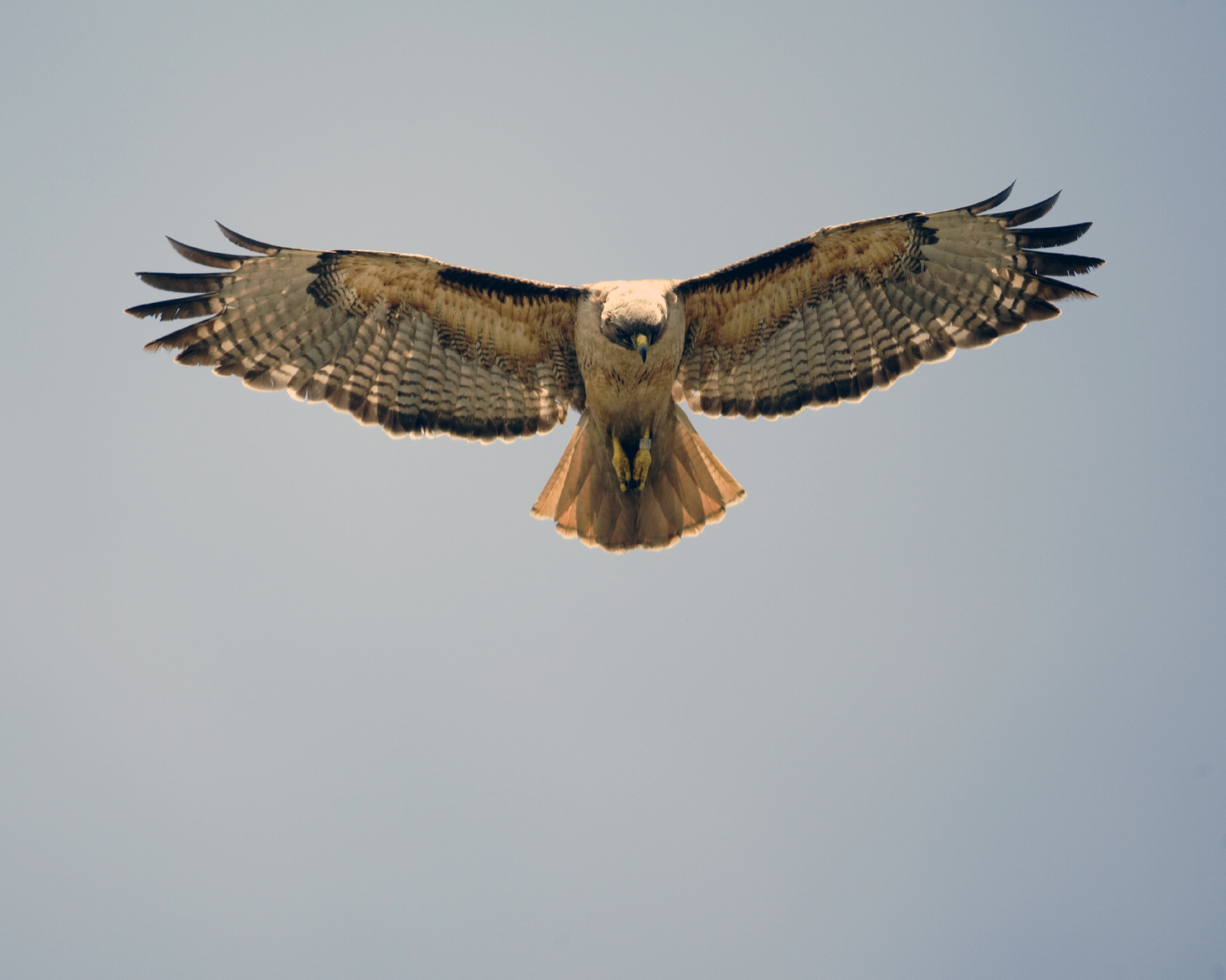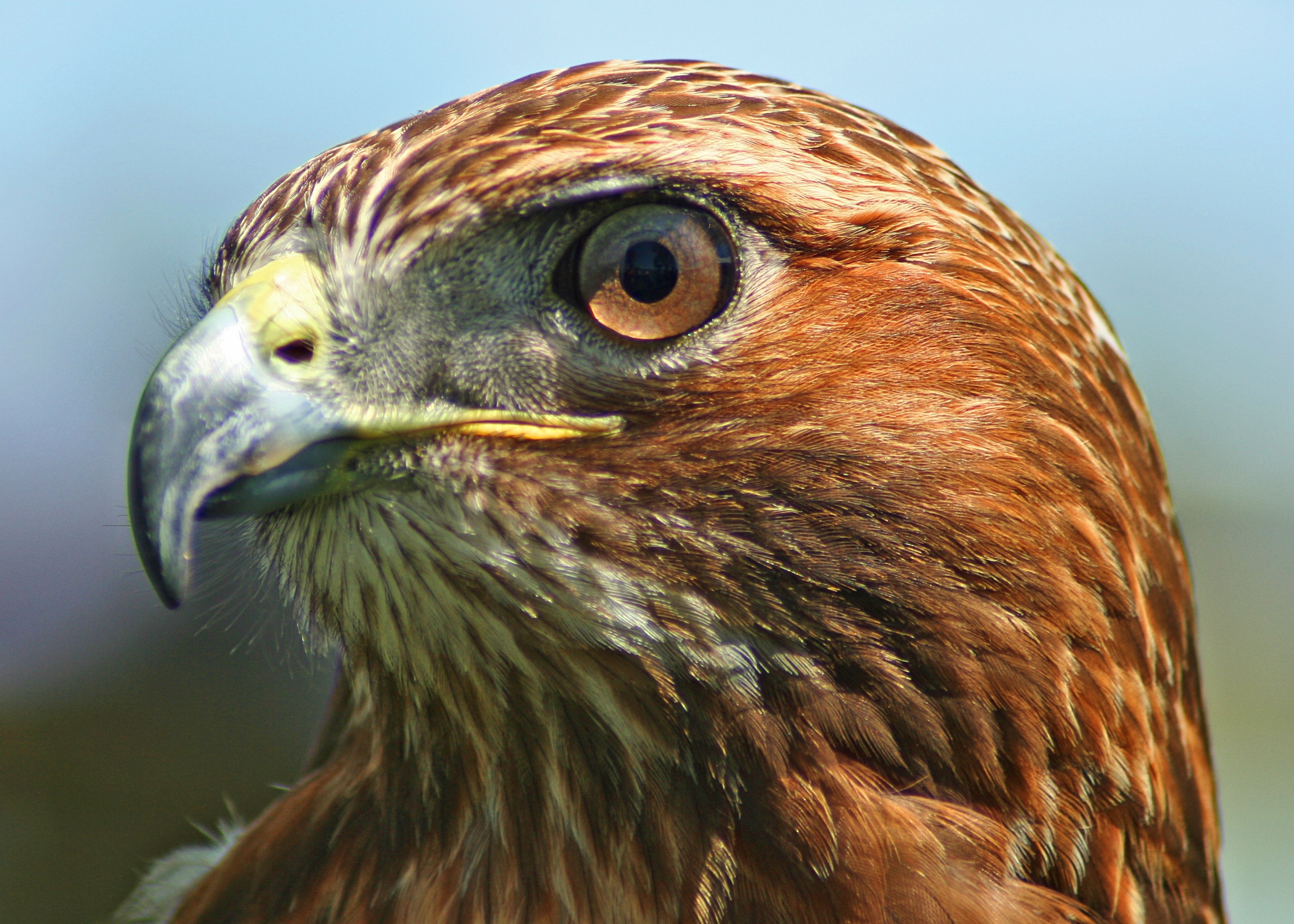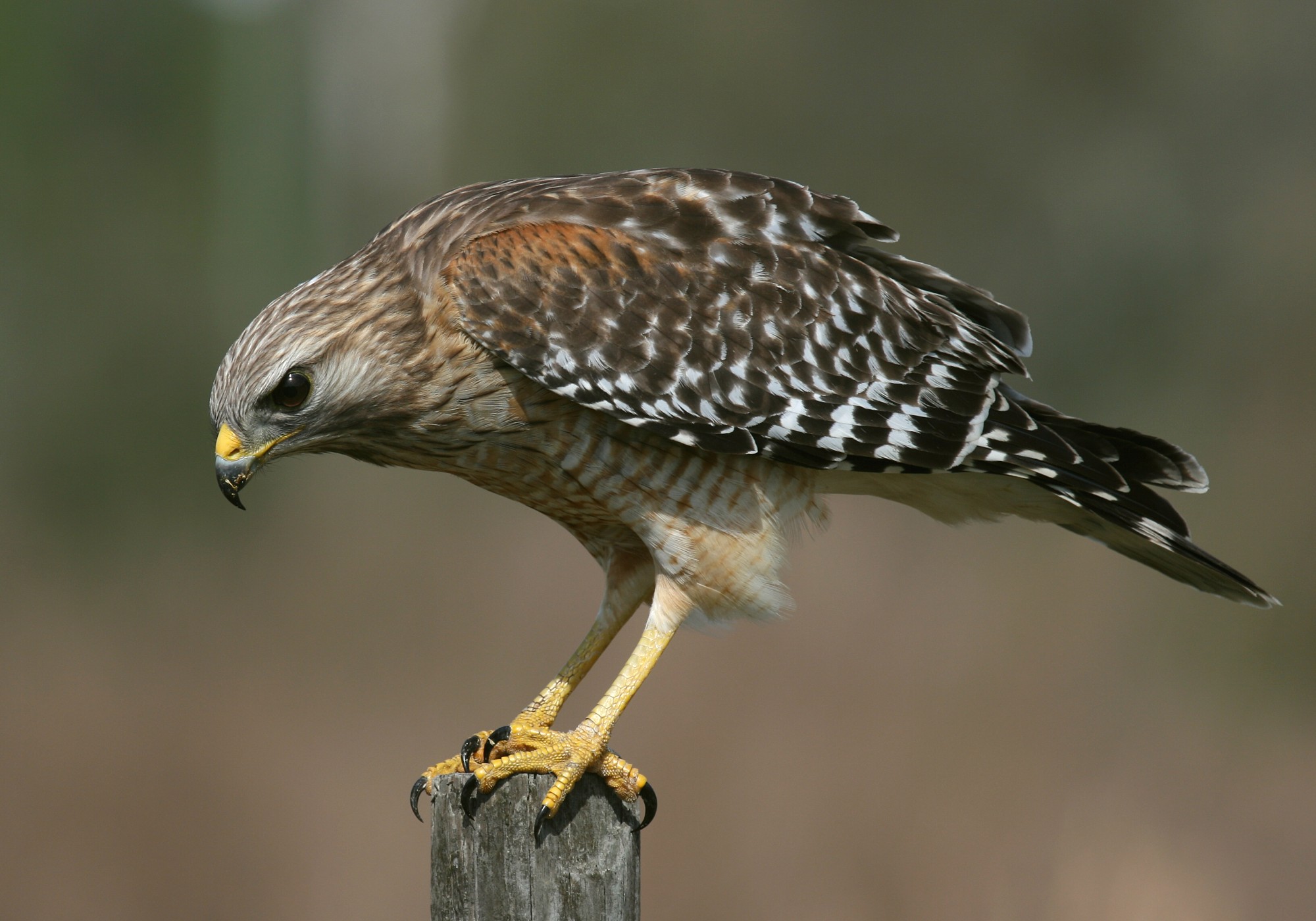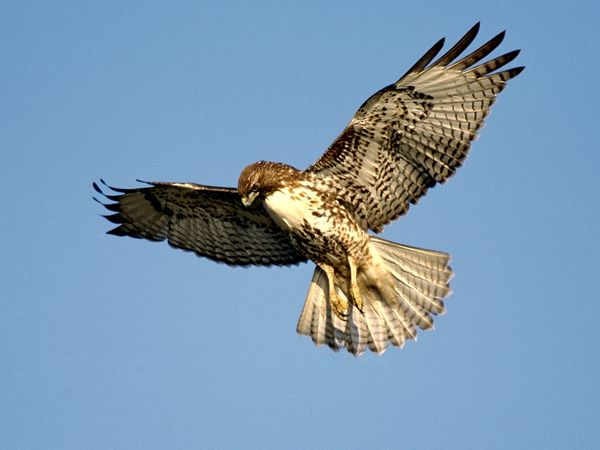
Hawks are a diverse group of birds adapted to
exploit a wide variety of habitats, prey, and
climatic conditions. Although varying in size
from the 75-gram male tiny hawk (Accipiter supercilliosus)
and pearl kite to the 6.5-kilogram female
harpy eagle (Harpia spp.), all hawks are distinguished
by sharp, strongly hooked bills, a
fleshy cere, and strong legs with sharp talons or
claws. Most are active and efficient hunters that
use their keen vision to target and track suitable
prey.
The 237 species of hawks are placed in the
avian order Falconiformes. Families within this
order include the booted eagles, harpy eagles,
buteo hawks, subbuteos, chanting goshawks,
accipiters, harriers, and kites. Only the fifty-four
species of accipiters are strictly considered true
hawks, but most raptor biologists and hawk enthusiasts
also include the buteo hawks, called
buzzards in Europe, within the category of hawks,
while the most liberal definition incorporates the
kites, harriers, and eagles as well.
Habitats and Lifestyles
Hawks are a widespread and successful group
that occurs on all continents and the larger islands.
They are absent only from Antarctica, the
ice-covered mountaintops, and the most remote
oceanic islands. Hawks are primarily birds of
woodland and woodland-edge habitats, and
reach their greatest diversity in the rain forests of
the tropics. They are components of all temperate
woodlands of varying density and diversity, but
some species occur in a wide variety of more open
habitats, including chaparral, grasslands, desert,
and tundra. Many species take readily to conifer
plantations and ornamental conifer stands, provided
that sufficient food is nearby. Black kites
(Milvus migrans), Cooper’s (Accipiter cooperi), redtailed
(Buteo jamaicensis), and Swainson’s hawks
(Buteo swainsoni) exemplify species that tolerate
human-modified habitats, especially farmlands,
pastures, and orchards. Given their need for large
territories and abundant prey, few species have either
the tolerance or ability to exploit urban landscapes,
although wooded suburbs and city openspace
habitats do attract an occasional furtive
nesting or roosting pair of red-tailed hawks or
brahminy kites (Hiliastur indus).
The daily lives of hawks center around finding
food and avoiding enemies. To ensure an adequate
food base, most hawks maintain large home
ranges for at least part of the year, and some remain
on territory throughout the year. Ifprey populations
suffice, hawks are sedentary, but if they
decline, hawks must move elsewhere. Some species
are nomadic, often wandering widely in
search of food, but most northern species move
southward in spectacular migrations along traditional
flyways each fall. Red-tailed hawks migrate
only a few hundred miles but others, such as the
lesser spotted eagle (Aquila pomarina) and Eurasian
buzzard (Buteo buteo), fly thousands of miles
to their wintering grounds. Their return migration
in spring is timed to ensure arrival on the
breeding grounds when weather conditions and
prey populations are optimal.
Most hawks are entirely carnivorous, or nearly
so, and use their remarkable eyesight and intimate
knowledge of their territory to locate, pursue,
and capture food. Their large eyes are set forward
in the head with overlapping fields of
vision. Each eye has a long focal length from lens
to retina, which produces a telescopic vision that
enables hawks to spot prey at great distances.
Hawk eyes also have two concentrations of visual
cells, called fovea, instead of one, as in other birds
and mammals. The central fovea and lateral fovea
apparently permit the simultaneous estimate of
both distance to and movement of prey, thereby
increasing hunting efficiency when pursuing agile,
fast-moving animals.
Most hawks are larger—some considerably
larger—than the prey that they take.Manyspecies
exhibit pronounced sexual dimorphism, with the
female being larger than the male. Bigger females
can better incubate eggs and protect young, but
the sexual size difference enables exploitation of a
much wider prey range. Sexual dimorphism is
best illustrated in the bird-eating accipiter hawks,
in which the larger female takes grouse and ducksized
prey while the smaller male pursues the
smaller and more agile birds. Conversely, insectivorous
and scavenger hawks show little or no
sexual dimorphism.
Almost all hawks that hunt live animals have
comparatively light bodies on large wings for a
low wing loading, which facilitates extended periods
of soaring in search of prey and also for carrying
prey. Many species show subtle differences in
overall size and wing shape that reveal differences
in hunting techniques or diet. For example, the
long, narrow wings and light bodies of swallowtailed
(Elanoides forficatus) and plumbeous (Ictinia
plumbea) kites enhance their aerial maneuverability
for catching insects just above the rain forest
canopy. In contrast, the long, broad wings of
hawks and eagles maximize lift needed to soar for
hours or to carry medium-sized mammals and
birds, along with an occasional reptile or amphibian.
The larger hawks and eagles take correspondingly
bigger prey up to the size of rabbits, hares,
hyraxes, sloths, small antelope, foxes, and young
deer.
The long tails and rounded wings of bird
hawks such as goshawks, sparrow hawks, hawkeagles
(Spizaetus spp.) and bat hawks (Macheirhamphus
alcinus) provide just the right combination
of speed and agility to pursue birds through
the often cluttered microhabitat just beneath the
woodland canopy.
The long, dihedral wings of harriers (Circus
spp.) provide a stable flying platform for slow
quartering flight over open grasslands and
marshes. Harriers use both eyes and ears to hunt
small mammals in the tall grasses and, like owls,
have a distinctive facial ruff that helps gather
sounds to pinpoint prey in the tall grasses.
Hunting and dietary specializations abound in
this group. At least twelve species of kites are insectivorous
or nearly so, but many other hawks
and eagles feed opportunistically on abundant locusts,
and grasshoppers, ants, termites, and locust
swarms invariably attract a variety of hawks and
other birds. Reptile specialists include the snake
eagles (Circateus spp) and serpent eagles (Spilornatus
spp.), which sit quietly for hours, patiently
watching for the slow and stealthy movements
of snakes. Possibly the most extreme dietary
specialist is the rufous crab-hawk (Buteogallus
aequinoctialis), which picks through aerial roots of
mangroves in search of crabs, but snail kites
(Rostrhamus sociabilis) and slender-billed kites
(Rostrhamus hamatus) focus almost exclusively for
pulmonate snails, which they extract with their
long, hooked bills.
Courtship and Nesting
Most hawks breed each year, but some of the
larger tropical eagles and snake eagles may breed
once every several years. All phases of the breeding
cycle of hawks are dependent on prey abundance:
In low prey years pairs often do not nest
and may not even establish a territory, while in
high prey years nesting success, measured by the
number of eggs produced, hatched, and young
fledged, is highest. Tropical hawks may nest at
any time of year, but usually do so during the dry
season. Temperate species are more strictly tied to
a spring and early summer nesting cycle when
prey abundance is maximal and longer days permit
extended hunting periods.
The breeding cycle of temperate species begins
when males or mated pairs claim and advertise
territories by often extravagant displays that may
include sky dancing, dives and swoops, perches,
calling, and posturing. Unmated males court females
with aerial displays such as circling, following
flights, sky dancing, and food transfers from
males to females. As courtship proceeds, the pair
bond is cemented by synchronized flights, following
flights, mutual preening, food begging by the
female, and courtship feeding.
Territory size depends on food needs and prey
density. Smaller tropical hawks may limit their
breeding activities to a hundred acres or so, while
the larger eagles that inhabit open habitats, such
as the Scottish golden eagles, sometimes establish
home ranges of thousands of acres on the moors
and grasslands. Most hawk territories are coneshaped,
with little or no overlap permitted near
the base of the cone, which is typically centered
near the nest site or feeding site.
Hawks build stick nests in trees (for example,
Cooper’s hawks, sharp-shinned hawks), on cliffs
(ferruginous hawks, Buteo regalis), bluffs and outcrops
(Swainson’s hawks, Buteo swainsoni), on
structures (ospreys, red-tailed hawks), or directly
on the ground (harriers). Depending on habitat,
some species are flexible in choice of substrate;
thus, red-tailed hawks may build their nests in
trees, on ledges, less frequently on structures, or
directly on the ground. Many hawks (ferruginous
hawks, Swainson’s hawks) readily accept artificial
platforms such as bridge abutments, piers,
telephone poles, and towers.
Both members of a pair bring sticks to the nest
site, but the female does the actual work of nest
building, arranging the materials into a compact
nesting platform with a shallow bowl. Many species
refurbish one or more nests year after year,
sometimes resulting in massive nesting platforms
of sticks and branches after many years of use.
Nests are generally lined with dried grasses or
mosses and many may decorate them with sprigs
of greenery.
Depending on species, fromone to ten eggs are
laid at two- to four-day intervals, and incubation
begins immediately. In most species, the female
incubates the eggs while the male supplies her
with food, which he may deliver to her or to a
nearby site. In some species the male may replace
her for brief periods of time to allow her to rest,
roost, or forage.
The female is often highly secretive during this
nesting phase as she hunkers down to incubate
the eggs. The young hatch in about one month
in the smaller accipiters and kites, and up to two
months in the larger eagles. Eggs hatch asynchronously,
producing a nest of uneven-aged
young. The female keeps constant company with
the newly hatched young, brooding them and
feeding them with food supplied by the male. As
the young grow, their food demands increase and
both male and female spend most of their time
hunting food to feed the young.
Adults become increasingly aggressive with
young in the nest. Generally, both adults participate
in nest defense, although the female is almost
invariably the most aggressive. Warning cries
(most hawks), power dives (many buteos), and
determined slashing attacks (goshawks) can
drive all but the most determined intruders away,
but unfortunately have little effect on humans intent
on destruction of the nest and young. Otherwise,
the only natural predators of eggs and
young are nest-robbing birds, chiefly corvus species,
mammals, other larger diurnal raptors, and
the larger owls, especially the Bubo species, which
take young during the night.
Survival of the young depends entirely on the
ability of the adults to find sufficient food. If prey
is sufficient, all of the young successfully fledge,
but if prey populations decline, one or all of the
smallest and weakest young of a nest die of starvation.
Nestling fratricide has been observed inmany
species and may help ensure survival of the strongest
young at the expense of their younger or
weaker nestlings.
After leaving the nest, the young usually stay
with the adults for several weeks or longer—a
year or more in some tropical eagles—learning
how to perfect their hunting skills and avoid enemies.
Many retain a streaked or spotted juvenile
plumage for several years that may help conceal
them from potential enemies. This plumage is replaced
at sexual maturity by adult coloring that
probably promotes sexual advertisement and territorial
displays.
Conservation and Economic Importance of
Hawks
Humans are the most consistent and potent threat
to hawks. Historically, huge numbers of hawks
were slaughtered by farmers, hunters, gamekeepers,
and trappers for sport and as control measures
designed to increase game and poultry populations.
Many hawks still fall victim to illegal
shooting by hunters and sportsman who prefer
live target practice, while accipiter hawks are
sometimes shot by pigeon fanciers or grouse managers
to protect their interests. Generally, the
larger buteo hawks and eagles are at greater risk
because of their size and habit of selecting open,
conspicuous perches for territorial posturing and
while hunting. Globally, some hawks are still
slaughtered for the taxidermy market, some are
taken for falconry, and some are captured as part
of the lucrative international trade in zoo specimens,
despite the fact that they are all federally
protected in most countries of the world.
Hawks also fall victim to pesticides and industrial
wastes, which accumulate within their tissues
and eventually reach harmful levels that result
either in death of the bird or reduction of its
productivity. Toxic levels of chemicals have been
documented in almost every hawk species on every
continent and have particularly affected populations
and productivity of fish-eating hawks,
such as the osprey and bald eagle.
While all of these forms of deliberate and inadvertent
human persecutions take an annual toll,
the most persistent threat to hawk populations results
from habitat destruction or fragmentation
and deforestation. Habitat losses are especially
critical for hawks, which require large areas of undisturbed
habitat for home range to provide a
food base for themselves and their young.
Although no species have become extinct in
the last several hundred years, twenty-nine species
are on the current list of endangered or threatened
species, and it took concerted efforts by state
and federal programs on many levels to save several
species, such as the bald eagle and osprey.
Bans on dichloro-diphenyl-trichloroethane (DDT)
and other environmental poisons, along with extensive
programs of captive breeding, nesting platforms,
and reintroduction programs have helped
reestablish bald eagles (Haliaetus leucocephalus) in
North America and red kites and white-tailed sea
eagles (Haliaetus albicilla) in Scotland. Conservation
programs continue to target the protection
and recovery of many species throughout the
world, including the harpy eagle in Latin America
and the Philippine eagle (Pithecophaga jefferyi) of
the Philippine Islands.
Hawk Facts
Classification:
Kingdom: Animalia
Phylum: Chordata
Subphylum: Vertebrata
Class: Aves
Order: Falconiformes
Families: Accipitridae
Subfamilies: Elaninae (white-tailed kites, five genera,
eight species); Milvinae (kites, eight genera,
fifteen species); Accipitrinae (hawks, five
genera, twenty-two species); Circinae (harriers,
three genera, eight species); Pandioninae
(ospreys, one genus, seven species)
Geographical location: All continents except
Antarctica
Habitat: Woods and woodland edges, rain forests;
may also inhabit chaparral, grasslands,
deserts, and tundra
Gestational period: One to two months, depending
on species
Life span: Eighteen to fifty years, depending on
species
Special anatomy: Talons; exceptionally keen eyesight;
nostril coverings (cere); sharp, hooked
bills
Other popular Animals
Photo Gallery of - Hawk








 Animalia Life
Animalia Life